Four side views of the Egyptian faience lotus. Photo credit: Jeff Veitch
An Egyptian Faience Blue Lotus
Object number: DUROM.1953.121
Object: Lotus bud
Owner: Durham University Oriental Museum
Collection: Rawnsley Collection
Material: Faience
Location of origin: Most likely Egypt
Function: Most likely decorative
Probable date: New Kingdom
Faience production

Labeled by the author. Photo credit: Jeff Veitch.
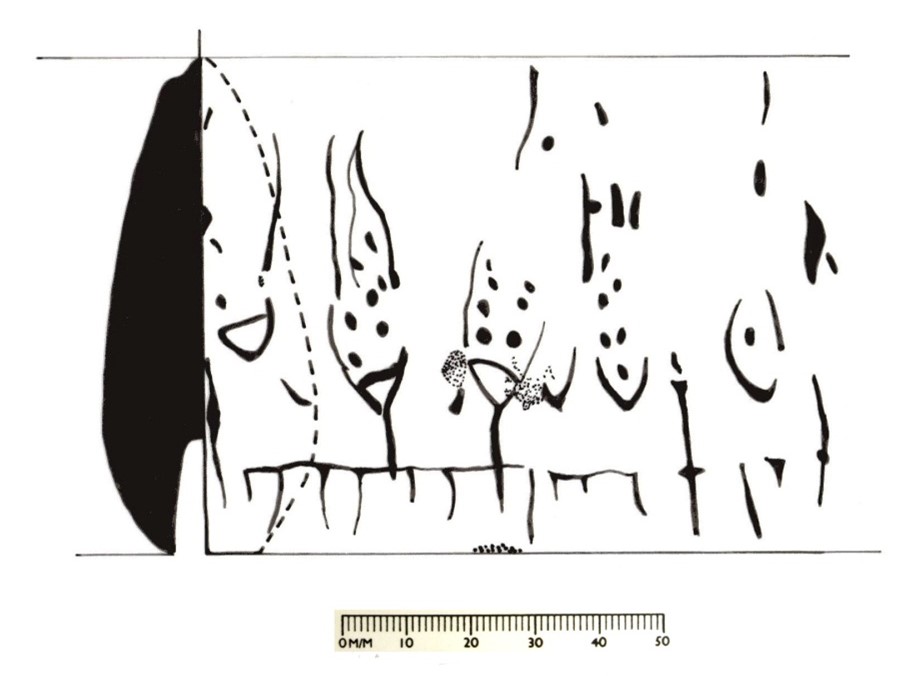
By the author.
The faience core
According to Vandiver, faience is composed of 92-99% SiO2, 1-5% CaO (lime), 0.5-3% Na2O (alkali/soda) and minor quantities of CuO, Al2O3, TiO2, MgO, and K2O (Nicholson 2000:186) – very likely unintentional impurities found in the sand and alkali sources. The source of the silica may come from either desert sand or crushed quartz pebbles and, depending on the source, – because of the type and amount of impurities among the silica – the faience core may present a brownish, pink or yellowish hue, or it may be white. “The crushed quartz pebbles are characterised by high purity, and therefore result in white bodies” (Tite 2008:37). Based on microscopic inspection of the fresh break found on top of the lotus bud, the most likely source for silica in this case was probably crushed quartz.
Apart from the main silica body, an alkali is needed in the faience to aid the material in sticking together. This may come from natron (“naturally occurring mixture of sodium carbonate and sodium sulphate”) or from the ashes of certain salt-loving plants (Nicholson 1993:50). It is possible to determine the alkali source by the high levels of magnesia or the presence of potassium in the case of use of plant ashes (Tite 2008:38,45; Nicholson 2000:187). EDXRF tests were carried out on the clean, broken, white tip. These displayed the presence of silica, iron, potassium and copper. It must not be assumed that because of the presence of potassium the alkali source is definitely plant ash. There is a possibility that the levels of sodium from a natron source are too low for the EDXRF machine to pick up and display. Thus, these results are far from conclusive and simply provide a rough list of elements present.
Once the basic faience materials were mixed, the bud would have been shaped. There are several ways of making faience objects: free-form modelling, moulding, throwing, abrading, layering, etc. (Nicholson 2000:188). However, given the irregular edges of the bud, it can be determined easily that although “fairly uncommon” (Nicholson 2000:188), this particular object must have been hand-moulded, and no other shaping technique has been applied to it after that.
The glazing, painting and firing
The second step to making a faience object would have been to glaze it, and there are three main ways of doing it: efflorescence, application and cementation. The most accurate way of determining the glazing technique is to use a scanning electron microscope on the edges of the glaze where it meets the faience core. The size of the object precluded this analysis, and taking a sample could not have been done without damaging the hard surface of the bud. Therefore, macroscopic and optical microscopic analyses were used.
| Technique | Characteristics | Evidence on lotus bud |
|---|---|---|
| Efflorescence | Minerals mixed in faience core migrate outwards during drying and glaze during firing. / Variable glaze thickness – thickets on the outer surface and rims. Rough or raised places (firing marks) (Tite 2008:49) / No glaze on the underside where no evaporation is possible (Nicholson 2000:189) | Yes / No / Yes – no glaze in insertion hole |
| Application | Slurry dipped or painted on and fired. / Drips and sideways runs of glaze (Tite 2008:49) | No |
| Cementation | Object surrounded by glazing powder and fired. Uniform glaze thickness / No firing marks in small objects. (Tite 2008:49) | No / Yes |

Optical microscope picture of the insertion hole. No glaze on the inside. Magnification: 7.5x
Age
Because it has not been possible to pin down a location for the excavation of this artefact, age can only be roughly approximated based on stylistic and technological characteristics and a rough comparison with similar specimens in other collections around the world. The following suggestion is far from definitive.

Architectural Ornament: Lotus Bud. Found in the Palace of Amenhotep III. New Kingdom. ca. 1390–1353 B.C. Accession Number: 11.215.531. Metropolitan Museum of Art, New York.
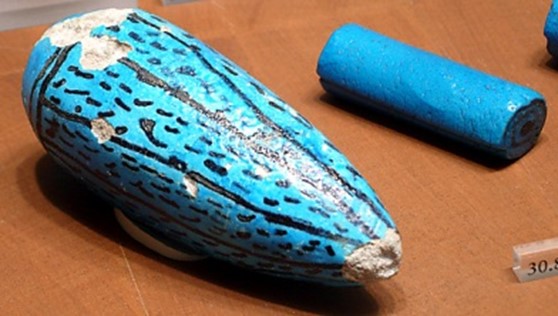
Bud of a water lily. Found in the Tomb of Thutmose IV. New Kingdom. ca. 1400–1390 B.C. Accession Number: 30.8.35. Metropolitan Museum of Art, New York.
Other examples whose images may not be reproduced because of museum licensing on photos have also been dated to the New Kingdom, a time recognised as “the zenith of Egyptian faience-working with widespread, varied production, masterpiece works, vivid use of polychromy and the dissemination of periods abroad” (Nicholson 2000:182). However, the difference between these and DUROM 1953.121 is stark. DUROM 1953.121 is mostly matte in finish, has only one colour glaze, and displays very crude black painting. Moreover, the examples above do not have a comparably irregular shape. Taking into account all of these observations, the most likely timeframe for DUROM 1953.121 is somewhere between the Old Kingdom (2686-2181 B.C.) and the Second Intermediate (1650-1550 B.C.) (Nicholson 2000:179-186).
It is unlikely that the object would have come before the Old Kingdom as this period in faience-making is described by Nicholson as one of “experimentation” (Nicholson 2000:179), and DUROM 1953.121 seems to conform with the traditional characteristics of later faience. According to Vandiver as presented in (Nicholson 2000:188), it is further possible that the lotus bud cannot have come after the Second Intermediate because there is no evidence of free-form modelling after that period. It could even be possible to narrow this timeframe down a little bit by suggesting it did not come after the Middle Kingdom (2055-1650 B.C.) as the “linear designs in dark paint” (Nicholson 2000:181) are not yet very good. Once again, it must be emphasised that these dates are tentative and based only on very limited information.
The Blue Lotus in Egypt
Flowers and plants in Egypt
According to the British Museum dictionary of Ancient Egypt, the name for Egypt used to be ‘Kemet’, which literally means ‘black land’ because of the fertile black soils that would be deposited annually from the inundation of the river Nile. In contrast to this ‘black land’, there was the desert, the ‘red land’, called Deshret (Shaw 1995:148). It was a natural duality in the Egyptian world-view which put the Nile vs. the desert, essentially life as opposed to death (Wilkinson 1994:12). It made sense, therefore, that all the vegetation that grew thanks to the Nile should be regarded as precious and closely related to the idea of a ‘good’ life.
Plants such as the lotus and papyrus, which grew naturally on the river were, as Frankfort put it, “essential constituents of this unchanging significant “landscape of the first time”” (Frankfort 1949:154) which had always had lotuses and papyrus and renewed itself with every flooding of the Nile. The vegetation around the Nile was not only part of the geography, but because of its vital role to Egyptian society, it was part of the mythology, religion and cultural iconography. The lotus and papyrus were taken as the representations of Upper and Lower Egypt respectively, and it was common to depict them entwined to represent the union of Egypt during the 1st dynasty (Hepper 1990:11).
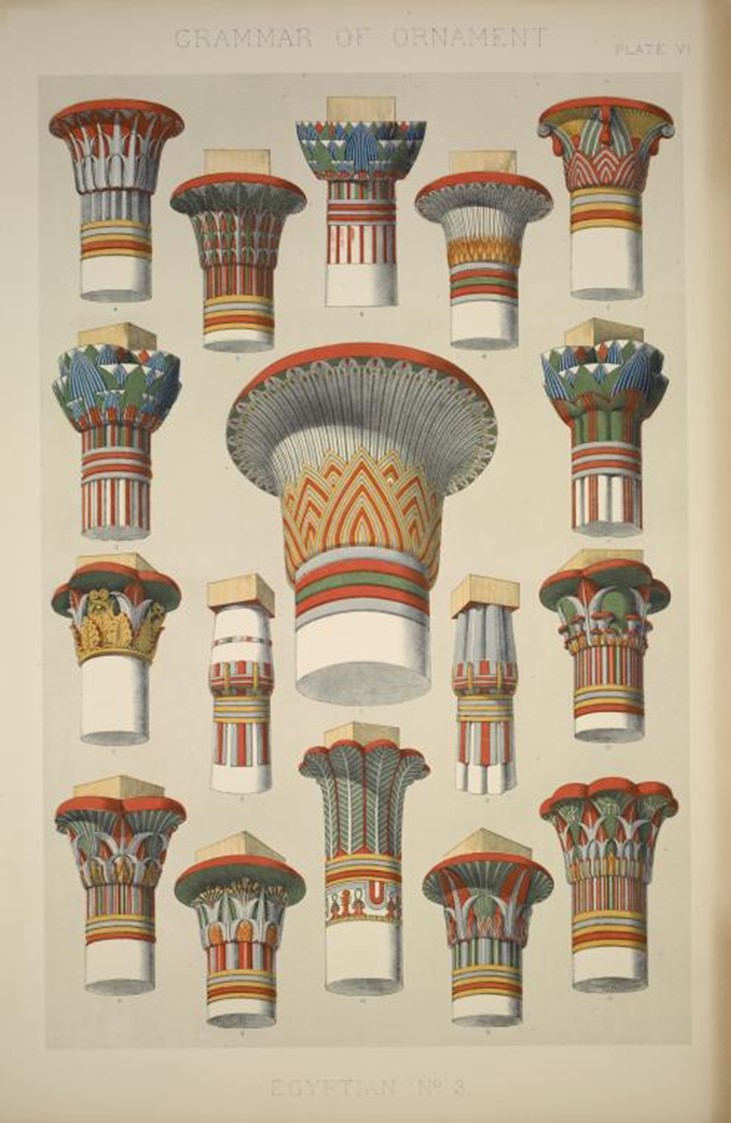
Examples of Lotus and Papyrus architectural columns. (Jones 1856:Plate VI)
The blue water lily, commonly known as the Egyptian blue lotus, was particularly important because of its natural properties of rising out of the water during the day and sinking back again at night (Shaw 1995:164), which emphasized the ideas of birth and renewal of life (Nicholson 1993:26). This lotus was the birthing place of the sun (Nefertem) in Egyptian mythology (Mercer 1949:242) and was therefore also the symbol of creation (Strouhal 1997:106; Wilkinson 1994:2). Furthermore, as the attribute of Osiris, the lotus itself became a “symbol of the sun of resurrection, and of creative force and power” (Burlington 1903:350).
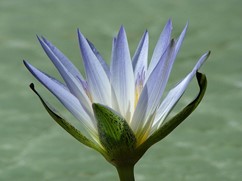
Nymphaea Caerulea. Image source: Wikipedia
The blue lotus in life
Due to the blue lotus’ importance in Egyptian society and beliefs, it was ever present in their celebrations. Lotus bunches would be sitting over banquet tables, threaded into women’s hair (Strouhal 1997:106), given out to guests as necklaces (Manniche 1997:42) and worn in wreathes and garlands as crowns for distinguished women (Converse 1879:246). Bouquets would also be offered to the gods, wreaths would be placed around sacrificial geese and bulls, and eventually, flower arrangements would be made for the dead as well (Semple 1929:430).
Edwards suggests that the imagery of receiving bouquets of lotus and papyrus flowers presents a blissful picture of domestic life (Edwards 1974:22). Perhaps this is also why there would be flowers inside Egyptian homes with special bowls and vases to “keep the heavy blossoms of the lotus in place” (Scott 1973:149). Additionally, according to Harer Jr. the blue water lily even acted as a narcotic or aphrodisiac when steeped in wine or beer (Harer Jr. 1985) Note the wreathe of persea leaves and lotus petals found on the wig of Princess Nany here.
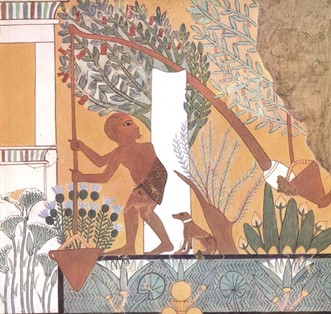
Gardener drawing water from a shaduf (Scott 1973:131). Image source: Wikimedia commons
Thus, having flowers such as the lotus was very important and a sign of status and good living, and to have such flowers, it was necessary to have expensive-to-keep gardens (Shaw 1995:108). Gardeners of high status were “entrusted with the task of providing vegetables, plants and flowers for the altar in cult ceremonies” (Carroll-Spillecke 2004:80). Of course, not everyone could afford to keep luscious gardens in the desert conditions of Egypt, and some took to design ‘tricks’. “By painting gardens on the interior walls of the courtyard, the planted area could be ‘enlarged’ with artistic illusion.
House owners of limited means could thus attempt to ‘compete’ with those who could afford a really large and luxurious garden as a symbol of their status and wealth” (Carroll-Spillecke 2004:108). Taking it one step further, gardens could not only be painted, but made artificially. Precisely because of faience’s entrenched meanings of life, rebirth, immortality and by extension, good health (Friedman 1998:15), it would have been the perfect material to make artificial lotuses, papyrus stalks and any other plant typical of an Egyptian garden. Such bouquets would require no upkeep but would maintain their symbolic significance for the household.
Friedman suggested that the polychrome bud in the Metropolitan Museum of Art, New York’s collection could be “an ornament on a shrine or in an architectural setting designed for royalty” or “that they were used in pairs on the lotus columns of the throne dais” (Friedman 1998:191). In addition to those suggestions, based on the description of Cooney of an 18th dynasty limestone relief at the Egyptian Collection of the Cleveland Museum of Art (Cooney 1967:285), the following is this author’s recreation of what a small bouquet of faience vegetation might have looked like. The model of the vase has been taken from the Metropolitan Museum of Art, New York (Accession number O.C.2761.
The blue lotus in death
“Spell for assuming the form of a lotus. To be said by N. I am this pure lotus that has ascended by the Sunlight and is at Re’s nose. I spend my (time) shedding it (i.e., the sunlight) on Horus. I am the pure (lotus) that ascended from the field.” (Allen 1974:70)
Because the Egyptians had such strong beliefs regarding life after death, it was only natural that what was important in life should be present in death. Thus, the tomb of Sebhekotep included a garden with a pool in the middle with fish and lotus flowers (Carroll-Spillecke 2004:16) where his soul could find rest and refreshment (Wilkinson 1994:2).
Similarly, just as the living gave each other wreaths of lotus flowers as symbols of longevity, it was appropriate to leave them with the dead as harbingers of rebirth and life beyond the physical plane (Petrie 1892:103, Strouhal 1997:106; Roach 2006). For example, in the tomb of Tutankhamun, among other plants, there were “papyrus, olive leaves, cornflowers, water-lily petals, wild celery leaves, pomegranate leaves and persea fruits, woven into garlands and necklaces” (Carroll-Spillecke 2004:100).
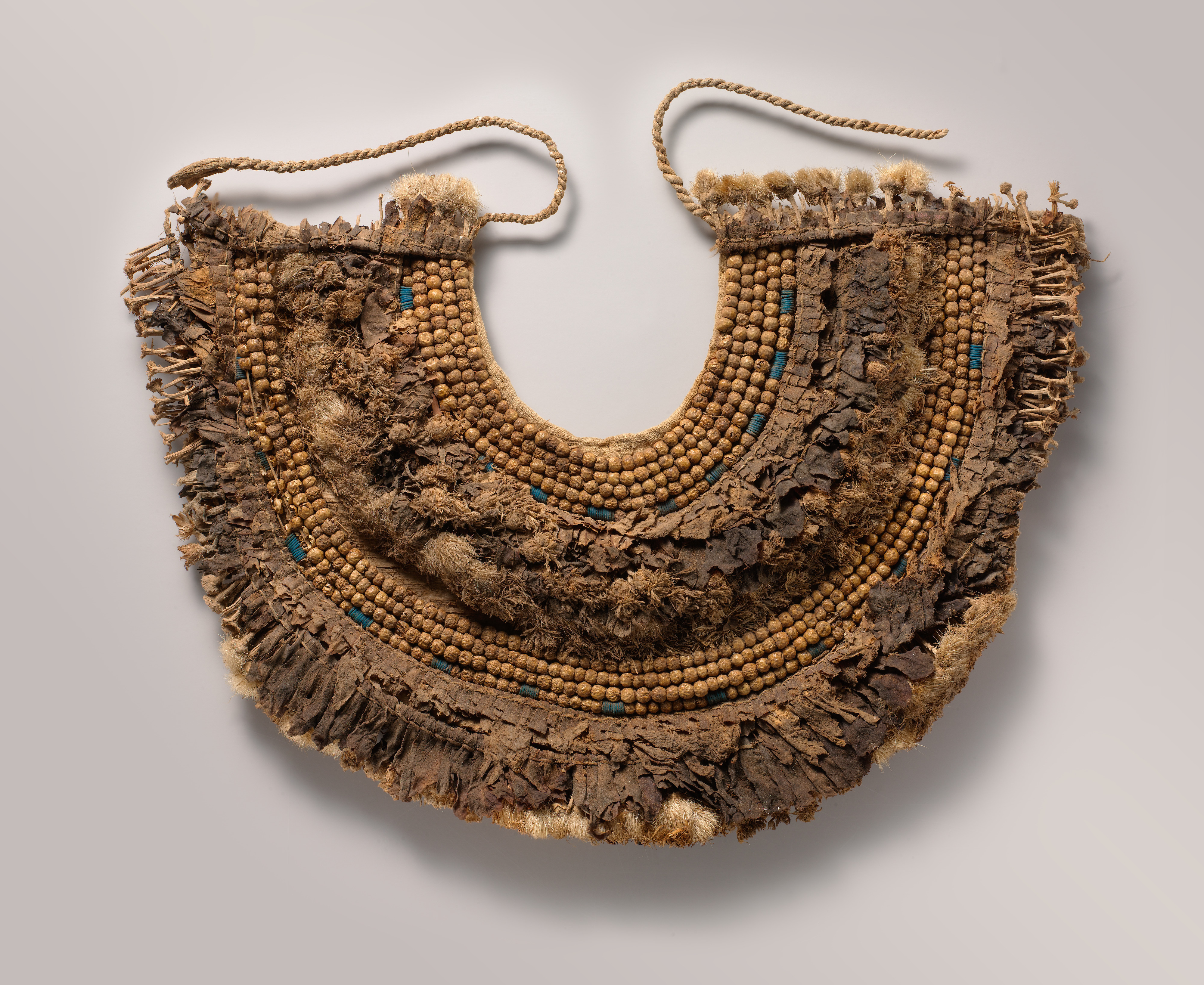
Floral collar from Tutankhamun’s embalming cache. Contains papyrus, olive leaves, persea leaves, cornflowers, blue lotus petals, Picris flowers, nightshade berries, faience and linen Accession Number: 09.184.214. Metropolitan Museum of Art, New York.
The perfume of the blue lotus was also of particular significance. According to Watterson, the lotus’ perfume “suggested to the Egyptians the perfume of Re’s sweat, the divine essence” (Watterson 1996:40), “the breath of life” (Quirke 1992:60). This would explain why both in depictions of life and death, the characters in paintings and carvings always smell lotus flowers. For an example, see the image of Khabekhent's ushabti chest here.
Most importantly, however, it was the link with the god Nefertem which made the blue lotus so important. He was the sun god who arose from the primeval waters of Nun at the beginning of creation. As the sun, he was born every day and died every night only to begin the cycle again the next day (Shaw 1995:74). In the exact same manner, the blue lotus would sink into the waters and ‘return to life’ every morning (Hayes 1938:182). In fact, “it was in order to identify himself with Nefertem and the act of creation and rebirth that Tutankhamun (1336-1327 B.C.) included among his funerary equipment a painted wooden representation of his own youthful head emerging from a lotus” (Shaw 1995:74).
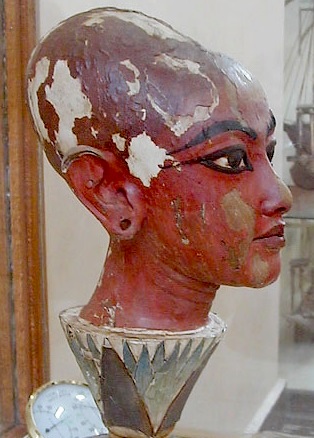
Tutankhamun’s head emerging from a lotus. Image source: Wikipedia
Conclusions
Artefact DUROM 1953.121 is a perfect example of Egyptian religious beliefs spilling over into their everyday lives and funeral practices. They used faience, a material of particular symbolic significance, in order to depict a plant which not only addresses their national landscape and the importance of the Nile to their civilisation and social structure, but which holds a deeper religious meaning in its representation of the never-ending cycle of life, death and rebirth.
If you liked this type of content, let me know on Twitter, and I will write more artefact study posts.
Bibliography
Allen, T.G (1974). The book of the dead: or, Going forth by day : ideas of the ancient Egyptians concerning the hereafter as expressed in their own terms. Chicago: Oriental Institute of the University of Chicago.
Ashmolean Museum. (?). Ancient Egypt and Nubia. Available: http://www.waa.ox.ac.uk/xdb/tours/ashegypt23sept.pdf. Last accessed 20th Jan 2013.
The Burlington Magazine for Connoisseurs. (1903). On Oriental Carpets. Article IV. The Lotus and the Tree of Life. The Burlington Magazine for Connoisseurs. 2 (6), 349-351, 353-354.
Carroll-Spillecke, M (2004). Earthly paradises : ancient gardens in history and archaeology. 2nd ed. London: British Museum Press.
Clarke, S; Engelbach, R (1930). Ancient Egyptian Masonry: The Building Craft. London: Oxford University Press.
Converse, E.M. (1879). The Lotus. The Art Journal (1875-1887), New Series. 5 (5), 246-247.
Cooney, J.D. (1967). Gods bearing gifts for the King. The Bulletin of the Cleveland Museum of Art. 54 (9), 279-289.
Edwards, I.E.S; British Museum (1974). The treasures of Tutankhamun. 2nd ed. London: M. Joseph.
Edwards, I.E.S; Burton, H; Boltin, L; Metropolitan Museum of Art, New York (1976). Tutankhamun, his tomb and its treasures. New York: Metropolitan Museum of Art.
Frankfort, H (1949). Ancient Egyptian religion : an interpretation. 2nd ed. New York: Columbia University Press.
Friedman, F.D. et al (1998). Gifts of the Nile : ancient Egyptian faience. New York: Thames and Hudson.
Germer, R. (1987). Ancient Egyptian Plant-Remains in the Manchester Museum. The Journal of Egyptian Archaeology. 73, 245-246.
Harer Jr., W.B. (1985). Pharmacological and Biological Properties of the Egyptian Lotus. Journal of the American Research Center in Egypt. 22, 49-54
Hayes, W.C. (1938). The Egyptian God of the Lotus: A bronze statuette. The Metropolitan Museum of Art Bulletin. 33 (8), 182-184.
Hepper, F.N; Royal Botanic Gardens, Kew (1990). Pharaoh's flowers : the botanical treasures of Tutankhamun. London: H.M.S.O
Jones, O (1856). The grammar of ornament / Illustrated by examples from various styles of ornament.. New York: Van Nostrand Reinhold Co.
Kaczmarczyk, A; Hedges, R.E.M (1983). Ancient Egyptian faience : an analytical survey of Egyptian faience from predynastic to Roman times. Warminster: Aris & Phillips.
Manniche, L (1997). Sexual life in ancient Egypt. 2nd ed. London; New York: Kegan Paul International.
Mao, Y (2000). Lead-Alkaline Glazed Egyptian Faience: Preliminary Technical Investigation of Ptolemaic Period Faience Vessels in the Collection of the Walters Art Gallery. Journal of the American Institute for Conservation, vol.39, no.2. The American Institute for Conservation of Historic & Artistic Works. 185-204. Available: https://www.tandfonline.com/doi/abs/10.1179/019713600806082739. Last accessed 7th Jan 2023.
Mercer, S.A.B (1949). The Religion of Ancient Egypt. London: Luzac.
The Metropolitan Museum of Art, New York. (2012). Online Collections. Available online.
Morenz, S (1973). Egyptian religion. Translated by Ann E. Keep. London: Methuen & Co Ltd.
Museé du Louvre. (2001). Khabekhent's funerary servant and ushabti chest. Available: https://www.louvre.fr/en/oeuvre-notices/khabekhent-s-funerary-servant-and-ushabti-chest. Last accessed 7th March 2021. Photo taken by R.M.N./F.Raux.
Nicholson, P.T. (1993). Egyptian faience and glass. Princes Risborough, Buckinghamshire, UK: Shire Publications.
Nicholson, P.T.; Shaw, I (2000). Ancient Egyptian materials and technology. Cambridge: Cambridge University Press.
Petrie, W.M.F (1892). Ten years' digging in Egypt, 1881-1891. London: Religious Tract Society.
Quirke, S; Spencer, A.J (1992). The British Museum book of ancient Egypt. New York: Thames and Hudson.
Roach, J. (2006). Ancient Flowers Found in Egypt Coffin. Available: http://news.nationalgeographic.com/news/2006/06/060629-egypt-flowers.html. Last accessed 30th Jan 2013.
The Science News-Letter. (1931). Garlands buried 3,000 years check Egypt's calendar. The Science News-Letter. 19 (509), 28.
Scott, N. (1973). The daily life of the ancient Egyptians. The Metropolitan Museum of Art Bulletin, New Series. 31 (3), 123-170.
Semple, E.C. (1929). Ancient Mediterranean Pleasure Gardens.Geographical Review. 19 (3), 420-443.
Shaw, I; Nicholson, P.T (1995). British Museum dictionary of ancient Egypt. London: British Museum Press.
Strouhal, E; Forman, W (1997). Life of the Ancient Egyptians. Liverpool: Liverpool University Press.
Tite, M.S. et al (2008). Production technology of faience and related early vitreous materials. Oxford: Oxford University School of Archaeology.
(de) Vartavan, C; Boodle, L.A (1999). Hidden fields of Tutankhamun : from identification to interpretation of newly discovered plant material from the Pharaoh's grave. London: Triade Exploration.
Watterson, B (1996). The gods of ancient Egypt. New York: Sutton Publishing.
Wilkinson, A. (1994). Symbolism and Design in Ancient Egyptian Gardens. Garden History. 22 (Summer), 1-17.